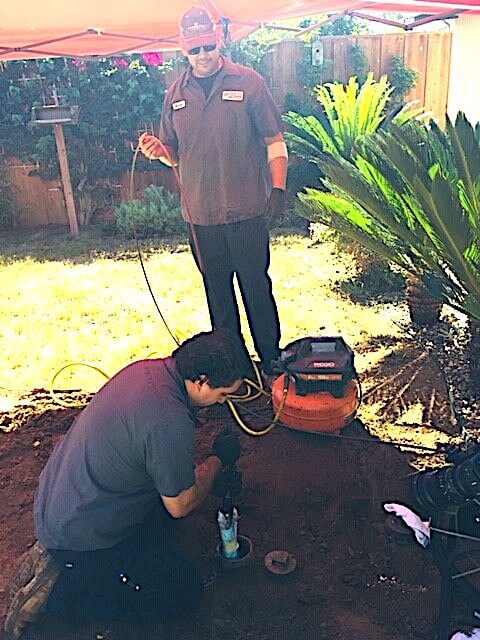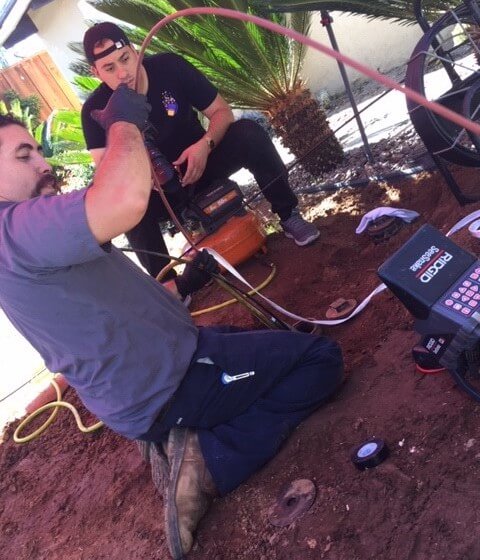
With today’s technologies, sewer line repair or replacement no longer has to mean digging up your lawn and jack-hammering through sidewalks and driveways. There are several great methods, with epoxy pipe-lining being one of the most popular. It’s minimally invasive and not a cheap short-term fix. It’s just as effective as traditional methods, and can even leave you with a stronger longer-lasting sewer main than you had in the first place.
Why Trenchless?
Many home and business owners groan when they hear their sewer line needs replacing or a major repair. Others may be shocked by the cost estimate. But if you can avoid the disruption and costs of digging, followed by pavement and landscaping repairs, sewer repair becomes less of a headache.
Sewer repair techniques have improved tremendously over the last few decades yet many plumbers can still only provide the “old fashioned” method of digging a long, deep trench from the building to the city sewer connection main at the street. Trenchless technologies avoid the time and costs of trenching, using only one or two relatively small holes for access. And if repairs are necessary underneath the building they avoid the major expense and near-impossibility of matching replacement terrazzo, marble, or tile.
Epoxy Pipe Lining
Pipe lining goes in as a liquid then “cures” (hardens) into a long-lasting solid. You may be surprised to know that it’s been in use since the 1940s, but didn’t really catch on until the 1970s with the introduction of structural pipe lining from Europe. Yet in a recent survey 3/4 of respondents had never heard of it.
Several trenchless technologies have been used over the decades.
- Slip lining inserts a smaller diameter pipe into the old line and pumps grout between the old and new pipes. It’s no longer used due to weaknesses of the grout.
- A cured in place pipe (CIPP, structural pipelining) inserts an epoxy-soaked liner inside the old pipe, presses it against the existing pipe, and lets it cure for a few hours.
- Spray or brush lining is quicker, easier, and less expensive. It’s viable only if there’s a small number of cracksbut many local codes don’t allow its use.
- As an alternative, pipe bursting pushes the existing line apart and pulls through a flexible HDPE plastic line. It’s most suitable for large diameter and badly damaged pipes.
In most situations, CIPP is the best choice. It can be used to fix cracks, minor sag, misaligned joints, and tree root damage. It can even correct pipes with large cracks up to an inch wide and a few feet long. It can be used on clay, ABS, PVC, concrete, copper, and cast iron lines. But it’s not suitable if the existing line is extensively damaged, severely sags, or is improperly sloped.
Pipelining does reduce the diameter a small fraction of an inch, but its smooth surfaces more than make up for that in maintaining good flow and drainage.
Proper installation is critical for a successful completion and a long lifetime so we first perform a thorough cleaning and video inspection of the entire line. We then follow industry best-practices using top-quality materials and never take shortcuts. Our expert installers are well-trained and always up to date on the latest products and techniques.
Better Than a Replacement?
- Avoids the cost, time, and disruption of digging along with re-establishing landscaping and replacing pavement and flooring.
- With seamless epoxy the full length of the line it actively prevents future problems, including resisting tree roots.
- It has the potential of saving thousands of dollars, even tens of thousands, over conventional methods. The lining itself costs more than standard sewer pipes but considering the cost of digging and other expenses associated with replacing a sewer line, trenchless lining typically costs 20% less.
- All work can be done in a day or less. As opposed to several days, possibly spread out over even more calendar days, for trenching.
- Long lasting and durable. It’s physically stronger than many traditional sewer pipe materials.
- Resists mineral scale as well as most chemicals, including alkali and acidic compounds.
All of this makes pipelining an excellent preventive measure when purchasing an older home or business.
So, yes, it’s better than a replacement.
ASAP Drain Guys & Plumbing – Experts Trenchless Sewer Repair, Epoxy Lining
ASAP Drain Guys & Plumbing has the expertise and experience to properly guide you through your sewer line replacement or repair.
We are A+ BBB rated and have been serving San Diego since 2001. Learn more or contact us any time.


